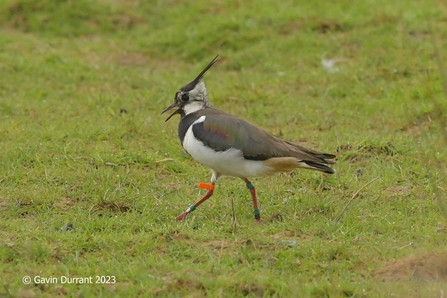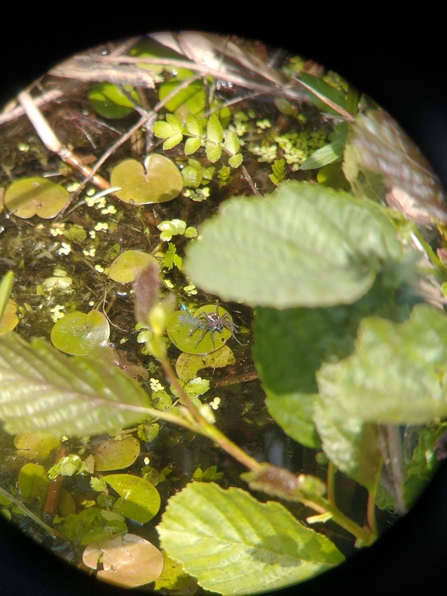Wild news from our reserves, 2nd June 2023
Yellow rattle, Hutchison's Meadow, Ben Calvesbert
The hawthorn blossom, complemented by cow parsley and alkanet at Martlesham Wilds has been looking stunning this spring. The team has been out surveying for the species that currently live on the reserve to create baseline data. Knowing what we have now will help us monitor the changes over the coming years.
Hutchison’s Meadow
Our Meadows & Heaths Warden, Ben Calvesbert, has been enjoying the beautiful spring flowers on this special meadow reserve. Hutchison's Meadow is a flower-rich grassland - a mix of spring-fed wet grassland and drier grassland associated with sand and gravels. The wet grassland includes species such as ragged-robin, common fleabane and there is a colony of southern marsh orchid. The drier parts of the meadow support typical meadow species such as sweet-vernal grass, red clover, yellow rattle, meadow and bulbous buttercups.
Trimley Marshes
We had a very enjoyable ‘Spring Spectacular’ event where loads of species were spotted by visitors. Carl Earrye sent us these lovely images of a male marsh harrier, black tern and great crested grebe from the day.
Water vole signs
Our Reserves Intern, Ella Broom, saw these feeding signs of water vole while out surveying. Water voles leave piles of vegetation in larders, and also create little latrines, so although they are not always easy to spot themselves, the signs they leave behind are.
Redgrave & Lopham Fen
Assistant Warden Debs Crawford has been enjoying a magnificent display of water violets growing in the middle great drain on the Fen and photographed a large red damselfly resting on some nettles.
Arger Fen
Warden Cormac Adlard spotted these gorgeous slow worms at Arger Fen amongst a glow worm and its larvae. Neither species are worms! Slow worms are legless lizards and glow worms are a species of nocturnal beetle. As larvae, glow worms feed on snails and, as adults, they don’t eat at all. Adult female glow-worms have a light-producing organ at the end of their abdomens. At night they use a bright, steady, yellowish-green light to attract flying males.

Slow worms and glow worm larvae, Arger Fen, Cormac Adlard
Knettishall Heath
Nature is incredible at reclaiming spaces, if it is just given a chance. We closed the old middle carpark at Knettishall Heath two years ago, and since then, rare heathland flora has returned to the disturbed, nutrient-poor soils. Assistant warden, David Stansfield, photographed the bright-red mossy stonecrop and tiny birdsfoot as well as common fiddleneck spilling out from under the trees.
Hopton and Market Weston Fen
Assistant warden Debs Crawford has been looking at the amazing array of fen flora in our valley fen reserves. Once common across our wetlands, land drainage and conversion has restricted these plants to a few precious places in Suffolk.
Butterwort is an insectivorous plant growing in their hundreds at Market Weston Fen. Its bright yellow-green leaves excrete a sticky fluid that attracts unsuspecting insects; once trapped, the leaves slowly curl around their prey and digest it. The acidic bogs, fens and damp heaths that common butterwort lives in provide little nutrients, so it has evolved this carnivorous way of life to supplement its diet.
Marsh lousewort is a hemi-parasite; this means its roots join with those of surrounding plants, siphoning off water, sugars and other nutrients. This activity weakens the neighbouring plants, reducing their height and shading ability. Its flowers are much loved by bumblebees for their nectar.
Joe Bell-Tye has also found some lovely fen flora at Market Weston – common milkwort, marsh arrowgrass, greater spearwort and heath speedwell.
Emerging dragonflies & damselflies
We’ve seen lots of dragonflies and damselflies emerging from their underwater larval stage across all of our reserves. Here are some photos showing exuviae (their sloughed skin).
Two-coloured mason bees nest in a snail shell
Hawk Honey captured this video of a two-coloured mason bee collecting mashed-up plant material to paste into its snail-shell nest at Lackford Lakes.
Two-coloured mason bees nest in a snail shell (https://youtu.be/7ML65wgaffs)
Two-coloured mason bees nest in a snail shell, Hawk Honey
Hawk also caught some rare footage of red mason bee females fighting over a nest chamber in the bee hotel at Lackford Lakes. It’s rare because this behaviour happens out of sight, usually.
Red mason bee females fighting over a nest chamber (https://youtu.be/EUk0ZQ_sf0w )
Red mason bee females fighting over a nest chamber, Hawk Honey, Lackford Lakes
Lound Lakes
Warden Andy Hickinbotham has counted 15 species of butterflies so far at Lound Lakes nature reserve, including this lovely wall brown and common blue butterfly.
He has also moved a herd of Suffolk red poll cattle into the 10-acre field.
Church Farm and Hen Reedbeds
Assistant Warden Daniel Doughty found these two moths in the moth trap recently at Church Farm – a buff tip and eyed hawk moth
Warden Jamie and the team moved our herd of eight British White cattle from their wintering grounds at Church Farm to their summer grazing reserve at Hen Reedbeds. It looks like they were happy to be back and to get tucked into all that lovely, lush grass!
British White cattle arriving back at Hen Reedbeds for the summer (https://youtu.be/qANlG7fXEoE)
British White cattle arriving back at Hen Reedbeds for the summer, Jamie smith
Carlton Marshes
North East Suffolk sites manager Matt Gooch was very excited about two fabulous bird species on the reserve this week – black winged stilts and a spoonbill. Black winged stilts are rare visitors to the UK. Black-winged stilts are found in a wide range across Europe, Africa, Asia, and Australia. The European population is mostly migratory, flying to Africa for the winter. Although the UK is too far north to be part of their usual range, birds from southern Europe do sometimes turn up here. Occasionally, pairs arrive and nest in the UK. Nesting attempts have become more common in recent decades, which has been linked to climate change. Warmer weather in southern Europe dries out the wetlands where they would usually nest, pushing them north to find more suitable sites.
Also at Carlton Marshes, Assistant Warden Gavin Durrant photographed a lapwing with a coloured ring on its leg. This has identified it as a bird ringed as a chick at nearby Berney Marshes in 2017. It’s great to see it doing well here.

Lapwing ringed as a chick in Berney Marshes in 2017
Lewis Yates spotted this fabulous fen raft spider enjoying a spot of damselfly lunch from the ‘spider bridge’ viewpoint at Carlton Marshes.

Fen raft spider eating a damselfly, Carlton Marshes, Lewis Yates











































